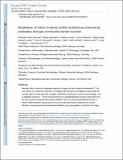| dc.contributor.author | Díaz-Pascual, Francisco | |
| dc.contributor.author | Hartmann, Raimo | |
| dc.contributor.author | Lempp, Martin | |
| dc.contributor.author | Vidakovic, Lucia | |
| dc.contributor.author | Song, Boya | |
| dc.contributor.author | Jeckel, Hannah | |
| dc.contributor.author | Thormann, Kai M | |
| dc.contributor.author | Yildiz, Fitnat H | |
| dc.contributor.author | Dunkel, Jorn | |
| dc.contributor.author | Link, Hannes | |
| dc.contributor.author | Nadell, Carey D | |
| dc.contributor.author | Drescher, Knut | |
| dc.date.accessioned | 2022-07-14T17:07:18Z | |
| dc.date.available | 2021-10-27T20:35:20Z | |
| dc.date.available | 2022-07-14T17:07:18Z | |
| dc.date.issued | 2019 | |
| dc.identifier.uri | https://hdl.handle.net/1721.1/136428.2 | |
| dc.description.abstract | © 2019, The Author(s), under exclusive licence to Springer Nature Limited. Bacterial cells in nature are frequently exposed to changes in their chemical environment1,2. The response mechanisms of isolated cells to such stimuli have been investigated in great detail. By contrast, little is known about the emergent multicellular responses to environmental changes, such as antibiotic exposure3–7, which may hold the key to understanding the structure and functions of the most common type of bacterial communities: biofilms. Here, by monitoring all individual cells in Vibrio cholerae biofilms during exposure to antibiotics that are commonly administered for cholera infections, we found that translational inhibitors cause strong effects on cell size and shape, as well as biofilm architectural properties. We identified that single-cell-level responses result from the metabolic consequences of inhibition of protein synthesis and that the community-level responses result from an interplay of matrix composition, matrix dissociation and mechanical interactions between cells. We further observed that the antibiotic-induced changes in biofilm architecture have substantial effects on biofilm population dynamics and community assembly by enabling invasion of biofilms by bacteriophages and intruder cells of different species. These mechanistic causes and ecological consequences of biofilm exposure to antibiotics are an important step towards understanding collective bacterial responses to environmental changes, with implications for the effects of antimicrobial therapy on the ecological succession of biofilm communities. | en_US |
| dc.language.iso | en | |
| dc.publisher | Springer Science and Business Media LLC | en_US |
| dc.relation.isversionof | 10.1038/S41564-019-0579-2 | en_US |
| dc.rights | Article is made available in accordance with the publisher's policy and may be subject to US copyright law. Please refer to the publisher's site for terms of use. | en_US |
| dc.source | PMC | en_US |
| dc.title | Breakdown of Vibrio cholerae biofilm architecture induced by antibiotics disrupts community barrier function | en_US |
| dc.type | Article | en_US |
| dc.contributor.department | Massachusetts Institute of Technology. Department of Mathematics | en_US |
| dc.relation.journal | Nature Microbiology | en_US |
| dc.eprint.version | Author's final manuscript | en_US |
| dc.type.uri | http://purl.org/eprint/type/JournalArticle | en_US |
| eprint.status | http://purl.org/eprint/status/PeerReviewed | en_US |
| dc.date.updated | 2021-05-18T18:40:29Z | |
| dspace.orderedauthors | Díaz-Pascual, F; Hartmann, R; Lempp, M; Vidakovic, L; Song, B; Jeckel, H; Thormann, KM; Yildiz, FH; Dunkel, J; Link, H; Nadell, CD; Drescher, K | en_US |
| dspace.date.submission | 2021-05-18T18:40:35Z | |
| mit.journal.volume | 4 | en_US |
| mit.journal.issue | 12 | en_US |
| mit.license | PUBLISHER_POLICY | |
| mit.metadata.status | Publication Information Needed | en_US |
